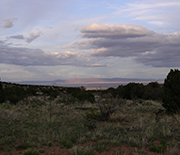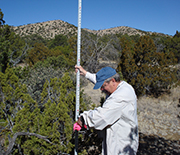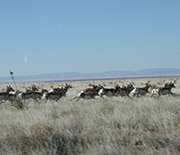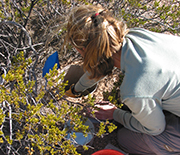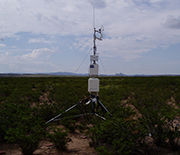News Release 18-055
NSF awards $6.4 million grant to Sevilleta Long-Term Ecological Research drylands site
Research in central New Mexico will focus on environmental changes in arid lands
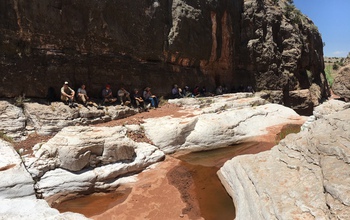
Scientists at Cibola Canyon, N.M., in NSF's Sevilleta LTER site.
July 30, 2018
This material is available primarily for archival purposes. Telephone numbers or other contact information may be out of date; please see current contact information at media contacts.
To discover how environmental change is affecting dryland ecosystems, the National Science Foundation (NSF) has awarded a five-year, $6.4 million grant in new support of the Sevilleta Long-Term Ecological Research (LTER) site in central New Mexico.
The location is one of 28 NSF LTER sites in ecosystems from deserts to salt marshes, coral reefs to forests.
A main goal of the Sevilleta LTER site is understanding how and why dryland ecosystems change over time. Sevilleta scientists will study how long-term environmental trends drive what happens in arid habitats. In particular, how does one type of dryland ecosystem become another, such as the transition from grassland to shrubland?
"Long-term research is critical to ecology," said Stephanie Hampton, director of NSF's Division of Environmental Biology, which funds the LTER site. "LTER data lead to findings that affect all of us, such as the discovery of the link between rodents and the Sin Nombre hantavirus, which can cause severe respiratory disease. NSF's LTER program allows researchers to discover ecological phenomena, assess the pace and impacts of environmental change, and forecast a range of future ecosystem scenarios."
Jennifer Rudgers, a scientist at the University of New Mexico (UNM) and principal investigator of the site, said that "funding from NSF's LTER program provides an opportunity to study the ecological consequences of variability in climate through long-term observations and experiments across the dryland ecosystems of the Southwestern U.S."
UNM scientists, in collaboration with ecologists at Rice University and Northern Arizona University, will lead the research. It will take place at the 230,000-acre Sevilleta National Wildlife Refuge in central New Mexico and at nearby natural areas.
The researchers will conduct studies important to the state of New Mexico and the Southwest U.S. region, Rudgers said, such as investigating what drives transitions in dryland ecosystems.
"Research at the LTER site includes the study of such factors as changes in vegetation, and in carbon and nitrogen cycles, that are critical to dryland ecosystems," said Rudgers. "We're focusing on the ecological consequences of two key aspects: rising temperatures and increasingly variable rainfall."
Arid areas, which currently make up more than 40 percent of the land on Earth, are expanding. Annual differences in temperature and in rain and snow patterns affect the ecology and evolution of the plants and animals that live there.
Sevilleta ecologists will evaluate the mechanisms that control dryland plant and animal populations and communities, as well as arid ecosystem transitions, by integrating long-term observations and experiments with theoretical, statistical and simulation models.
Scientists will combine long-term data with results of experiments to build models that predict ecological change; for example, what will happen when rainfall is low one year and high the next.
In addition to basic research, the LTER site will offer training opportunities, external research collaborations, and a commitment to inclusion and outreach, including a partnership with New Mexico's flagship science outreach group, the Bosque Ecosystem Monitoring Program.
Scientists at the Sevilleta LTER will recruit and train a diverse workforce through activities at all levels of learning, from "schoolyard" activities to undergraduate, graduate and professional training, as well as through collaborations with local, regional and national land managers.
-NSF-
-
A view of Sevilleta toward the Los Pinos Mountains from the base of the Ladron Mountains at sunset.
Credit and Larger Version -
Scientist Doug Moore measures the heights of juniper trees as part of a Sevilleta LTER study.
Credit and Larger Version -
The pronghorn antelope is among the species that live in or pass through the Sevilleta site.
Credit and Larger Version -
Sevilleta researcher Michell Thomey unearths below-ground biomass in what's called a root donut.
Credit and Larger Version -
A tower at the Sevilleta LTER site provides scientists with data on an ecosystem transition zone.
Credit and Larger Version
Media Contacts
Cheryl Dybas, NSF, (703) 292-7734, email: cdybas@nsf.gov
Steve Carr, University of New Mexico, (505) 277-1821, email: scarr@unm.edu
The U.S. National Science Foundation propels the nation forward by advancing fundamental research in all fields of science and engineering. NSF supports research and people by providing facilities, instruments and funding to support their ingenuity and sustain the U.S. as a global leader in research and innovation. With a fiscal year 2023 budget of $9.5 billion, NSF funds reach all 50 states through grants to nearly 2,000 colleges, universities and institutions. Each year, NSF receives more than 40,000 competitive proposals and makes about 11,000 new awards. Those awards include support for cooperative research with industry, Arctic and Antarctic research and operations, and U.S. participation in international scientific efforts.
Connect with us online
NSF website: nsf.gov
NSF News: nsf.gov/news
For News Media: nsf.gov/news/newsroom
Statistics: nsf.gov/statistics/
Awards database: nsf.gov/awardsearch/
Follow us on social
Twitter: twitter.com/NSF
Facebook: facebook.com/US.NSF
Instagram: instagram.com/nsfgov



